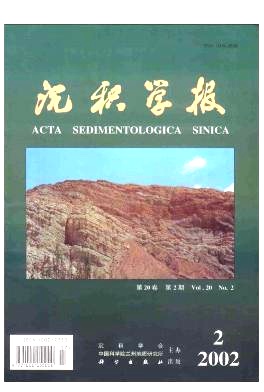PENG Jun, ZHENG RongCai, CHEN JingShan, CAI XunYu, WEI JingChun. Short-Term BaseLevel Cycle Sequence Analysis of Nadu Formation in Baise Basin[J]. Acta Sedimentologica Sinica, 2002, 20(2): 203-209.
| Citation:
|
PENG Jun, ZHENG RongCai, CHEN JingShan, CAI XunYu, WEI JingChun. Short-Term BaseLevel Cycle Sequence Analysis of Nadu Formation in Baise Basin[J]. Acta Sedimentologica Sinica, 2002, 20(2): 203-209.
|
Short-Term BaseLevel Cycle Sequence Analysis of Nadu Formation in Baise Basin
- 1.
State Key Laboratory of oil and gas reservoir geology and exploitation,Sout hwest Petroleumlnstit ute,Nanchong Sichuan 637001;
- 2.
State Key Laboratory of oil and gas reservoir geology and exploitation,Chengdu university of Technology,Chengdu 610059;
- 3.
Nanning Branch of dian- Oian- gui Petroleum exploration and development lnstit ute lnstit ute,Nanning 530023
- Received Date: 2001-05-10
- Rev Recd Date:
2001-08-30
- Publish Date:
2002-04-10
-
Abstract
According to the identification mark of the short-term base-level cylce interface and under the guidance of the theory and technology of the high-resolution sequence stratigraphy, the authors divide the short-term base-level cycle of Nadu Formation in Baise Basin into three basic structure types which are up-deepening non-symmetry, up-shallowing non-symmetry and symmetry from up-deepening to up-shallowing. Furtherly in the light of the high or low accommodation, and the thickness of the uprising periods and subsiding periods of the short-term base-level cycle, seven subtypes of structure are distinguished and they are up-deepening non-symmetry of low accommodation (Type A1) or high accommodation(Type A2)up-shallowening non-symmetry of low accommodation (TypeB1) or high accommodation (Type B2)complete~nearly complete symmetry (Type C1)in complete symmetry with the majority of uprising semi-cycle(Type C2) or subsiding semi-cycle(Type C3).In this paper the sedimentary environment,stacking patterns,lithlolgic association and sedimentary dynamic processes of each basic type and subtype of structure is discussed in detail. And the development position of the advantage reservoir sand body in each structure type are pointed out. On the basis of these studies, the change rule and distribution pattern of the short-term base-level cycle sequence are summarized. From the terrigenous to lacustrine environment, the short-term base level cycle sequence types have the change rule that is in succession from Type A1 to Type A2, then to Type C2, to Type C1 Type C3 Type B1 and at last to Type B2.In the structure types of short-term base-level cycle sequence, the advantage reservoir sand body mainly develops in Type A1, secondly in Type A2Type B1 and Type C1. In this paper, the authors also briefly discuss the application of the short-term base-level cycle sequence in oil and gas exploration and development stage.
-
References
|
[1]
|
1. Cross T A,Lessenger M A.Sediment Volume Partitioning: Rationale for Stratigraphic Model Evaluation and High-Resolution Stratigraphic Correlation[M].Accepted for Publication in Norwegian Petroleums-Forening Conference Volume,July,1996.1~24
2. 邓宏文。美国层序地层研究中的新学派-高分辨率层序地层学[J].石油与天然气地质,1995,16(2):89~97[Deng Hongwen.A new school of thought in sequence stratigraphic Studies in U.S.:high-resolution sequence strutigraphy[J].Oil and Gas Geology,1995,16(2):89~97]
3. 邓宏文,王洪亮,李熙吉吉。层序地层基准面的识别、对比技术及应用[J].石油与天然气地质,1996,17(3):177~184[Deng Hongwen,Wang Hongliang,Li Xizhe.Identification and correlation techniques of sequence stratigraphic base-levels and their application[J].Oil and Gas Geology,1996,17(3):177~184]
4. 邓宏文,王洪亮,李小孟。高分辨率层序地层对比在河流相中的应用[J].石油与天然气地质,1997,18(2):90~95[Deng Hongwen,Wang Hongliang,Li Xiaomeng.Application of high-resolution sequence stratigraphic correlation to fluvial facies[J].Oil and Gas Geology,1997,18(2):90~95]
5. 王洪亮,邓宏文。地层基准面原理在湖相储层预测中的应用[J].石油与天然气地质,1997,18(2):96~102[Wang Hongliang,Deng Hongwen.Application of base-level principle in prediction of lacustrine reser voirs[J].Oil and Gas Geology,1997,18(2):96~102]
6. 郑荣才,彭军,吴朝容。陆相盆地基准面旋回的级次划分和研究意义[J].沉积学报,2001,19(2):249~255[Zheng Kongcai,Peng Jun,Wu Chaorong.Grade division of base-level cycles of terrigeneous basin and its implication[J].Acat Sedimentologica Sinica,2001,19(2):249~255]
7. 郑荣才,尹世民,彭军。基准面旋回结构与叠加样式的沉积动力学分析[J].沉积学报,2000,18(3):369~375[Zheng Rongcai,Yin Shiming,Peng Jun.Sedimentary dynamic analysis of sequence structure and stacking patlern of base-level cycle [J].Acta Sedimentologica Sinica,2000,18(3):369~375] |
-
-
Proportional views

-






 DownLoad:
DownLoad: